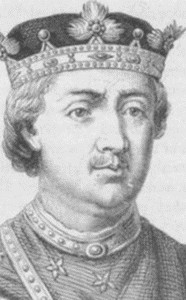© 2006 All Rights Reserved. Do not distribute or repurpose this work without written permission from the copyright holder(s).
Printed from https://danginteresting.com/king-arthurs-grave/
This article was written by Stephanie Benson, one of our shiny new Dang Interesting writers.

The legend of King Arthur is an enduring one, so popular that it has been shared for centuries. The earliest accounts are simple: A heroic king rescues his country. The story evolved over the centuries, and further elements such as Camelot, the Round Table, and Merlin were added in for flavor. Some versions of the legend state that Arthur did not truly die, but rather that he was put in an enchanted sleep— and it is said that he will return again in an hour of great need.
For hundreds of years the Arthur story has been retold in its various forms, though even ancient historians considered it nothing more than a myth. But in the twelfth century, evidence surfaced that suggested that one of history’s most popular figures might have been more than a mere legend.
In the year 1190, the monks of Glastonbury Abbey in England announced an incredible discovery. According to historical record, the monks began to experience dreams and visions about King Arthur around that time, which prompted them to consult with King Henry II (AD 1133-1189). Henry informed them of a long-kept secret of the royal family: Arthur’s remains were buried in the churchyard of St. Dunstan in Glastonbury. A search was soon commissioned.
Upon excavating the indicated area, the searchers unearthed a massive oak trunk, buried sixteen feet deep just as Henry had described. Inside was a human skeleton which confirmed that they had discovered something special. It was absolutely gigantic. It appeared to be much taller than an average man, and the space between the eye sockets was as wide as the palm of a man’s hand. Apparently, this famous king was truly larger than life.

This skeleton was not alone in its coffin. Alongside it was a second, lying next to a plait of blonde hair. The identities of the two remains were described on an archaic lead cross which was found nearby, inscribed with the Latin message “Hic jacet sepultus inclitus rex Arthurus in insula Avalonia,” meaning “Here lies interred the famous King Arthur on the Isle of Avalon.”
All in all, this was exciting stuff. Men and women flocked to Glastonbury from the surrounding regions, and King Henry II interred the ancient bones. Glastonbury soon became wealthy from the offerings and alms given by those who made the pilgrimage, and few questioned the authenticity of the find. Indeed, a few decades earlier the contemporary historian Geoffrey of Monmouth had claimed that Glastonbury was built on the site of ancient Avalon.
It turns out that Arthur’s grave was not the first historically significant discovery made by the monks of Glastonbury. In 1184, they had allegedly found the remains of St. Patrick. However, this claim failed to convince most people, since it was widely believed that St. Patrick had been buried in Ireland. Soon after this incident, the monks of the town had found the bones of famed Saint Dunstan. This discovery, too, was not widely believed. Though St. Dunstan had begun his career in Glastonbury, he ultimately relocated to Canterbury and had been buried there.
It was several years later that the monks found the grave of King Arthur. The discovery was fortuitous, because the monastery was rumored to be in financial trouble. In 1184, the monastic building and church of Glastonbury had been razed to the ground in a fire, leaving the monks of the town in dire monetary straits. However, if an abbey were in possession of a sacred relic, then it would be assured revenue. People would visit from far and wide to see pieces of the cross, clothes and objects of the saints… and bones. King Arthur was not a religious figure, but as one of the foremost heroes in legendary history, his remains attracted a great deal of medieval tourists.

While the circumstances of the discovery cast it in a suspicious light, the story was supported by King Henry II King Edward, who had succeeded Henry III and who had no need for money. But he may have had political motives in backing such a hoax; England was being ruled by Norman conquerors. The Saxons generally accepted these rulers, but those belonging to the Celtic fringes did not. Among those who revolted against the Norman invaders, it was widely believed that Arthur would one day return and fend off the invaders. With proof that the Celts’ savior was truly dead, Edward would secure a greater hold on his subjects. He interred the bones of King Arthur and Queen Guinevere, symbolically aligning his reign with that of England’s most famous hero and putting the matter to rest.
Taken all together, the evidence strongly suggests that the grave of King Arthur was just an elaborate hoax, designed to benefit several parties. Unfortunately the bones and the cross went missing centuries ago, so the evidence cannot be examined using modern techniques. But if they are ever rediscovered, even if they prove to be forgeries, these artifacts would be an interesting testament to the enduring legacy of political trickery and propaganda.
© 2006 All Rights Reserved. Do not distribute or repurpose this work without written permission from the copyright holder(s).
Printed from https://danginteresting.com/king-arthurs-grave/
Since you enjoyed our work enough to print it out, and read it clear to the end, would you consider donating a few dollars at https://danginteresting.com/donate ?